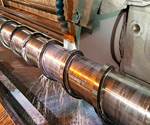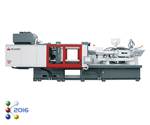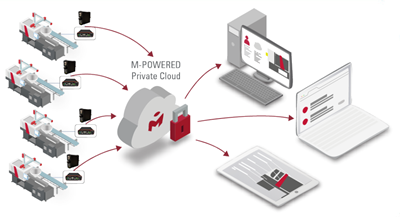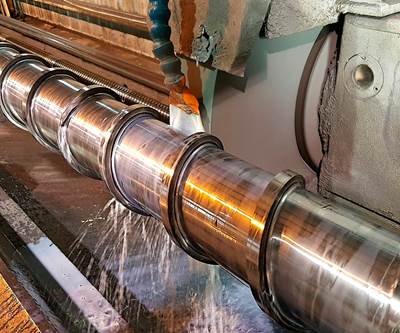New Technology Opens a Predictive Window Onto Screw Wear
Despite their integral role in transforming pellets fed through the hopper into parts ejected from the mold, visibility into the performance, health and efficiency of screws is difficult to discern for many reasons, not the least of which being the fact they’re located inside a barrel.
New technology from various machinery OEMs gives injection molders insight into their machines’ screws without forcing them to remove them for time consuming visual inspections, or being forced shut down machine if they should fail.
As part of its M-Powered suite of IoT tools, plastics processing machinery supplier Milacron is entering the field of predictive analytics, using data garnered from the machine to anticipate component failures and prevent downtime. Milacron describes its M-Powered Predictive Maintenance as a novel non-invasive method for monitoring performance. The company’s efforts began with heater bands in May 2019, before moving on to hydraulic pumps in September of that year and screws in October. In June 2020, it began offering screw efficiency analysis.
In particular, Milacron says its predictive analytics tools—created in collaboration with its long-time IoT partner ei3—seek to avoid component failures, as well as determine overall machine health and process efficiency. Milacron says the program could also allow molders to preemptively stock wear parts before they break down, allowing key components to be replaced without the downtime hit of a failure forcing a machine offline and further delays as replacement parts are ordered and delivered. In the future, they hope to use the data to determine part quality as well, linking real-time machine data with the parts that are being molded.
Milacron’s Ed Jump said the M-Powered tools capture process parameters that allow the software to infer an efficiency and repeatability/health score for the screw and its tip, as well as heater bands and pumps. Jump said the company began investigating the technology starting with a few machines back in 2014, and used the intervening six years of learning to continue to fine tune the algorithm, with the last two years focused on predictive analysis of machine data.
In the coming year, Jump said the company is exploring using the data to give real-time process recommendations to molders, alerting them to the set of parameters that could lead to the most-efficient process. The tool is already heavily used for remote service and technical support, two areas that require man power on the part of the OEM. Going forward, particularly as it relates to processing advice, the goal for M-Powered is to become more automated for the customer.
Offering an example of a real-world intervention by the program, Jump said the software could alert the molder that a particular machine’s heater bands are operating at 60% health, and tell them to order new ones and change the current ones. The company can work with the customer to determine when and how they would want to be notified with such alerts.

Milacron’s M-Powered suite of predictive and analytics tools includes an energy compensation dashboard.
The technology will also give insights into machine efficiency as it relates to overall sustainability from an energy use and scrap standpoint. “We have a big focus on other ways to help customers, including industry trends,” Jump said. “Look at sustainability—don’t just replace a component when they go bad but when the machine is detrimental to environment.”
Cars are a go-to metaphor but the analogy Jump draws for where M-Powered and predictive maintenance are headed is apt. Over the years, cars have evolved from no diagnostics whatsoever, to generic engine lights, to “change oil” based on mileage to “change oil in 1488 miles” based on how the car’s been driven and in what conditions. Likewise, the very analog fuel gauge has graduated from “a quarter of a tank” guesstimate to a highly specific mileage range that reacts to how the car’s being operated. So too, machines offer more specificity in their readings with molders in mind.
“It’s all about understanding economics of molding,” Jump says. “What each customer is trying to do and augmenting the customer’s intelligence—when to change parts, when to change process—to turn our users into smart users and help them understand what the machine or maintenance department needs.”
Jump says it’s not enough to simply tell the customer that screw is deteriorating, instead say: “Here’s how much it is costing you to use that screw, and here’s what it’s doing to your machine cycle,” Jump says. “We show you in real time what it’s doing to your cycle.”
OEM Efforts Expand
Engel has also introduced a condition monitoring platform for condition-based predictive maintenance to barrier screws, using a device that mounts on the barrel and assesses the component without its removal.
At K 2016, Wittmann Battenfeld introduced a condition monitoring system (CMS) as an optional equipment package for molding machines. The CMS accesses and records values measured by existing and new sensors installed for this purpose. Among the values captured are vibration, plasticizing torque, screw stroke, and closing behavior of the check valve in the injection unit.
Related Content
Production Monitoring Automates Molder’s Planning, Operations
DCT saves 60 man-hours per week by shifting from paper records and discrete spreadsheets to a shared, automatic production monitoring platform.
Read MorePTXPO Preview: Intouch Monitoring Previews Mobile App
The provider of real-time monitoring and MES technologies will showcase its production monitoring suite, including a preview of a new mobile app.
Read MoreDigital Manufacturing: Two Medical Molders Embrace Industry 4.0
‘Digitalization’ and ‘connectivity’ are loaded terms—shorthand for a whole new way of doing business. It can’t be accomplished in one go. But two Midwest molders in the sensitive medical field are already feeling the benefits of their initial steps in that direction.
Read MorePortable, Handheld CMM Enables Simplified Dimensional Measurement, 3D Scanning of Large Parts
Eastec 2025: Keyence’s WM-6000 provides full CMM and CAD capabilities, enabling 3D/GD&T measurements, contour profile checks, CAD comparison and reverse-engineering.
Read MoreRead Next
Injection Molding: Milacron Expands Industry 4.0 Platform
In a series of webinars, plastics machinery manufacturer Milacron revealed details of its M-Powered suite of Industry 4.0 tools, including expanding functionalities.
Read MoreScrew Wear: Understanding Causes, Effects, and Solutions
Here’s how to find out what’s happening to your screw and what to do about it.
Read MoreMilacron to Show Wide Range of New Technologies at K 2016 Milacron
New developments in injection and blow molding, extrusion, hot runners, and tooling will be featured.
Read More

























